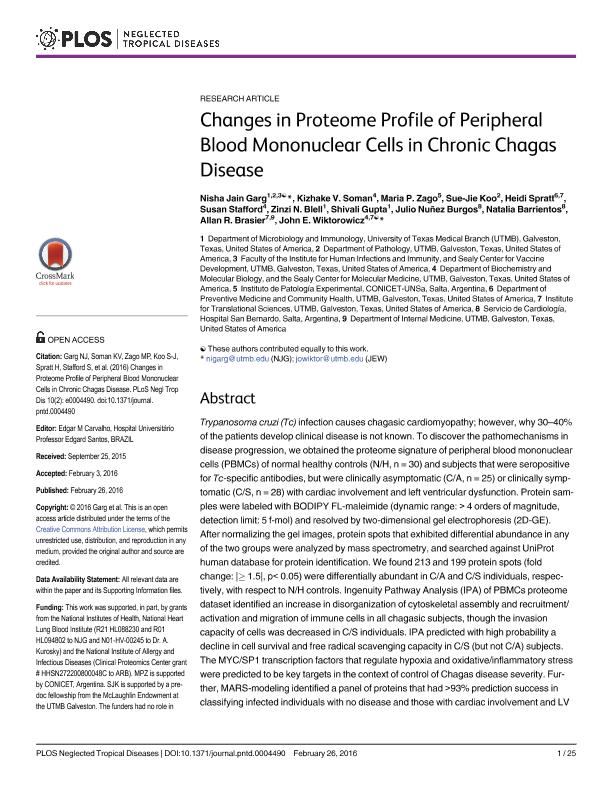Artículo
Changes in Proteome Profile of Peripheral Blood Mononuclear Cells in Chronic Chagas Disease
Garg, Nisha Jain; Soman, Kizhake V.; Zago, María Paola ; Koo, Sue-Jie; Spratt, Heidi; Stafford,Susan; Blell, Zinzi N.; Gupta, Shivali; Nuñez Burgos, Julio; Barrientos, Natalia Mariel; Brassier, Allan R.; Wiktorowicz, John E.
; Koo, Sue-Jie; Spratt, Heidi; Stafford,Susan; Blell, Zinzi N.; Gupta, Shivali; Nuñez Burgos, Julio; Barrientos, Natalia Mariel; Brassier, Allan R.; Wiktorowicz, John E.
 ; Koo, Sue-Jie; Spratt, Heidi; Stafford,Susan; Blell, Zinzi N.; Gupta, Shivali; Nuñez Burgos, Julio; Barrientos, Natalia Mariel; Brassier, Allan R.; Wiktorowicz, John E.
; Koo, Sue-Jie; Spratt, Heidi; Stafford,Susan; Blell, Zinzi N.; Gupta, Shivali; Nuñez Burgos, Julio; Barrientos, Natalia Mariel; Brassier, Allan R.; Wiktorowicz, John E.
Fecha de publicación:
26/02/2016
Editorial:
Public Library of Science
Revista:
Neglected Tropical Diseases
ISSN:
1935-2735
Idioma:
Inglés
Tipo de recurso:
Artículo publicado
Clasificación temática:
Resumen
Trypanosoma cruzi (Tc) infection causes chagasic cardiomyopathy; however, why 30–40% of the patients develop clinical disease is not known. To discover the pathomechanisms in disease progression, we obtained the proteome signature of peripheral blood mononuclear cells (PBMCs) of normal healthy controls (N/H, n = 30) and subjects that were seropositive for Tc-specific antibodies, but were clinically asymptomatic (C/A, n = 25) or clinically symptomatic (C/S, n = 28) with cardiac involvement and left ventricular dysfunction. Protein samples were labeled with BODIPY FL-maleimide (dynamic range: > 4 orders of magnitude, detection limit: 5 f-mol) and resolved by two-dimensional gel electrophoresis (2D-GE). After normalizing the gel images, protein spots that exhibited differential abundance in any of the two groups were analyzed by mass spectrometry, and searched against UniProt human database for protein identification. We found 213 and 199 protein spots (fold change: |≥ 1.5|, p< 0.05) were differentially abundant in C/A and C/S individuals, respectively, with respect to N/H controls. Ingenuity Pathway Analysis (IPA) of PBMCs proteome dataset identified an increase in disorganization of cytoskeletal assembly and recruitment/activation and migration of immune cells in all chagasic subjects, though the invasion capacity of cells was decreased in C/S individuals. IPA predicted with high probability a decline in cell survival and free radical scavenging capacity in C/S (but not C/A) subjects. The MYC/SP1 transcription factors that regulate hypoxia and oxidative/inflammatory stress were predicted to be key targets in the context of control of Chagas disease severity. Further, MARS-modeling identified a panel of proteins that had >93% prediction success in classifying infected individuals with no disease and those with cardiac involvement and LV dysfunction. In conclusion, we have identified molecular pathways and a panel of proteins that could aid in detecting seropositive individuals at risk of developing cardiomyopathy.
Palabras clave:
Proteome
,
Chronic Chagas Disease
,
Human Pbmcs
Archivos asociados
Licencia
Identificadores
Colecciones
Articulos(IPE)
Articulos de INST.DE PATOLOGIA EXPERIMENTAL
Articulos de INST.DE PATOLOGIA EXPERIMENTAL
Citación
Garg, Nisha Jain; Soman, Kizhake V.; Zago, María Paola; Koo, Sue-Jie; Spratt, Heidi; et al.; Changes in Proteome Profile of Peripheral Blood Mononuclear Cells in Chronic Chagas Disease; Public Library of Science; Neglected Tropical Diseases; 10; 2; 26-2-2016; 1-25; e0004490
Compartir
Altmétricas



